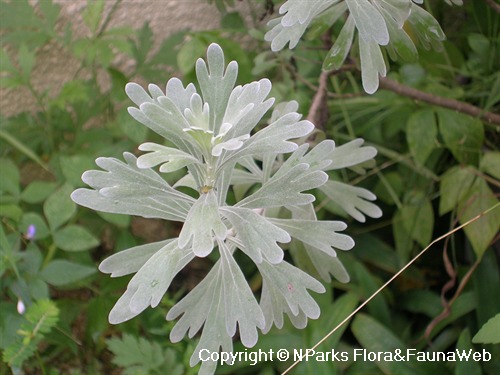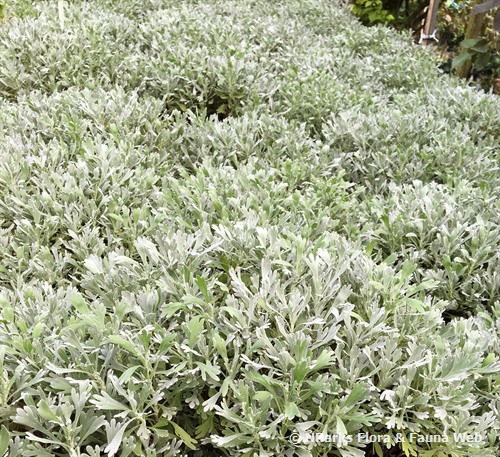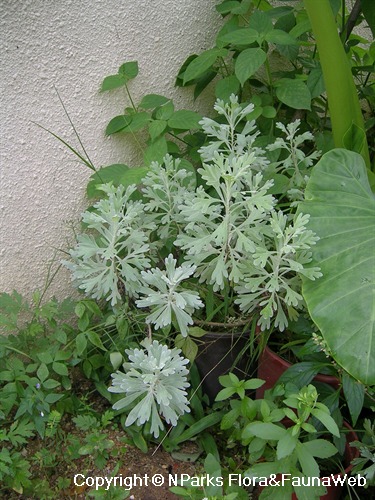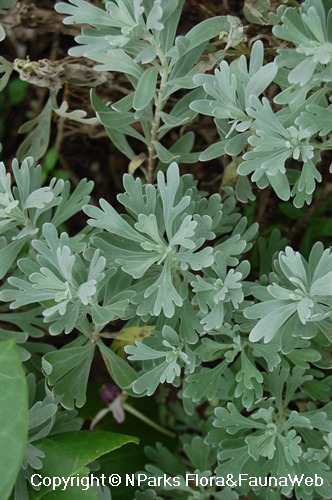
Back
Crossostephium chinense (L.) Makino
| Family Name: | Asteraceae (Compositae) |
| Synonyms: | Tanacetum chinense, Chrysanthemum artemisioides, Crossostephium artemisioides, Artemisia judaica, Artemisia chinensis |
| Common Name: | Chinese Wormwood, 香菊, 芙蓉菊 |
Name
Classifications and Characteristics
| Plant Division | Angiosperms (Flowering Seed Plants) (Dicotyledon) |
|---|---|
| Plant Growth Form | Shrub |
| Lifespan (in Singapore) | Perennial |
| Mode of Nutrition | Autotrophic |
| Maximum Height | 0.3 m |
Biogeography
| Native Distribution | Taiwan, S. China, Philippines, Ryuku Islands (Japan) |
|---|---|
| Native Habitat | Terrestrial (Coastal Forest) |
Description and Ethnobotany
| Growth Form | Woody shrub that is highly branched with erect branches. |
|---|---|
| Foliage | Leaves are fleshy, spathulate or oblanceolate, and have a velvety texture on both sides. They are spirally arranged and sessile (lacking a definitive petiole). Leaves are typically entire or trilobate, but occasionally bilobate or dissected into more than 3 lobes. |
| Stems | Woody stem with light brown bark. Leaves are absent on the lower portion of the stem near the base, but are densely clustered at the branch tips. |
| Flowers | Compound flower resembles the yellow center of a Daisy. Each is composed of numerous disk florets and some ray florets. Inflorescence is a raceme with 1 major axis directly connected to short-stalked compound flowers. In Java, flowering occurs during most parts of the year. |
| Fruit | Fruits are small and egg-shaped or oblong (1.5 mm long). Fruit is classified as an achene, a dry, indehiscent fruit that usually contains a single seed. In the tropics, fruits are rarely produced. |
| Habitat | Located on limestone formations, raised coral reefs or areas along the coast, such as coastal forests. |
| Cultivation | Plant in alkaline soil with good drainage, preferably in a pot. Allow the soil to dry somewhat before re-watering. This species is usually not susceptible to pests. |
| Etymology | The genus name "Crossostephium" is derived from 2 Greek words, "krossoi" which means tassels and "stephos" which means crown. The reference is to a crown-like appendage found on the fruits of some species in this genus. The species epithet "chinense" means that this species is from China. |
| Ethnobotanical Uses | Food (Herb or Spice) Others: This species contains an inhibitor of the enzyme alpha-glucosidase which might be used to treat diabetes (Wu et al. 2009). Other compounds that likely have a medicinal effect are taraxerol, taraverone and taraxeryl acetate which occur throughout the plant body. Taraxerol was effective against inflammation and cancer-causing compounds in mice. In Indochina, tumors are treated by placing dried, crushed leaves on them. In Taiwanese traditional medicine, this species is used to treat cough, flu and infections of the windpipe, as well as cases of poisoning and arthritic pain. In Vietnamese and Chinese traditional medicine, it is also used to treat cough, as well as menstrual disorders. |
Landscaping Features
| Landscaping | This shrub has attractive silvery leaves. Dense clusters of trilobate leaves at the branch tips produce a decorative, flower-like pattern. It would blend in well with other silver-coloured plants. Alternatively, it provides contrast when located next to green plants. It may also be used as a border plant. |
|---|---|
| Desirable Plant Features | Ornamental Foliage |
| Landscape Uses | General, Flowerbed / Border, Container Planting, Coastal |
| Thematic Landscaping | Silver Garden |
Plant Care and Propagation
| Light Preference | Full Sun |
|---|---|
| Water Preference | Moderate Water |
| Plant Growth Rate | Moderate |
| Rootzone Tolerance | Fertile Loamy Soils, Well-Drained Soils, Saline Soils / Salt Spray, Disease / Pest Resistant |
| Maintenance Requirements | Low |
| Diseases | Usually no problems. |
| Propagation Method | Seed, Stem Cutting |
| Propagation Method Remarks | Propagate by seed or softwood cuttings. In the tropics, it may be difficult to obtain seed. |
Foliar
| Foliage Retention | Evergreen |
|---|---|
| Mature Foliage Colour(s) | Silver / Grey |
| Mature Foliage Texture(s) | Velvety / Furry / Tomentose |
| Foliar Type | Simple / Unifoliate |
| Foliar Arrangement Along Stem | Spiral |
| Foliar Shape(s) | Non-Palm Foliage (Spathulate) |
| Foliar Venation | Pinnate / Net |
| Foliar Margin | Entire, Palmately Lobed |
| Foliar Apex - Tip | Rounded |
| Foliar Base | Cuneate |
| Typical Foliar Area | Microphyll ( 2.25cm2 - 20.25 cm2 ) |
| Leaf Area Index (LAI) for Green Plot Ratio | 4.5 (Shrub & Groundcover - Dicot) |
Non - Foliar and Storage
| Bark Colour(s) | Light brown |
|---|---|
| Stem Type & Modification | Woody |
| Root Type | Underground (Tap Root) |
Floral (Angiosperm)
| Flower Colour(s) | Yellow / Golden |
|---|---|
| Flower Symmetry | Radial |
| Inflorescence Type | Raceme |
| Flowering Period | Free-Flowering |
| Flowering Habit | Polycarpic |
Fruit, Seed and Spore
| Fruit Classification | Simple Fruit |
|---|---|
| Fruit Type | Indehiscent Dry Fruit , Achene |
Image Repository
Others
| Master ID | 594 |
|---|---|
| Species ID | 1889 |
| Flora Disclaimer | The information in this website has been compiled from reliable sources, such as reference works on medicinal plants. It is not a substitute for medical advice or treatment and NParks does not purport to provide any medical advice. Readers should always consult his/her physician before using or consuming a plant for medicinal purposes. |



